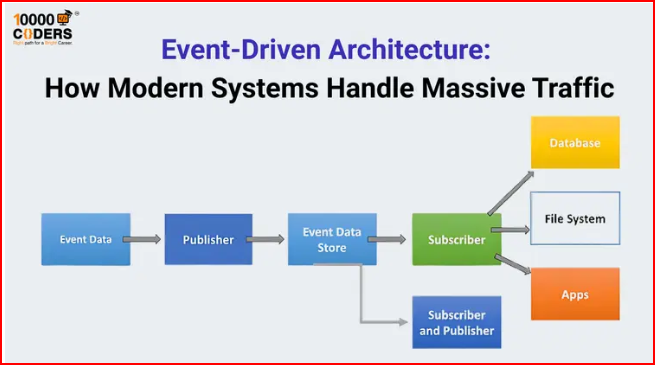Introduction
Event-Driven Architecture (EDA) has become a cornerstone of modern system design, enabling applications to handle massive traffic loads while maintaining scalability and responsiveness. This guide explores the fundamental concepts, patterns, and implementation strategies of EDA.
What is Event-Driven Architecture?
Event-Driven Architecture is a software design pattern that emphasizes the production, detection, consumption, and reaction to events. In EDA, components communicate through events rather than direct method calls, creating loosely coupled systems that can scale independently.
Key Components
// Example of an event structure
const orderEvent = {
eventId: "evt_123456",
eventType: "ORDER_CREATED",
timestamp: "2024-04-03T10:00:00Z",
payload: {
orderId: "ORD_789",
customerId: "CUST_456",
items: [
{ productId: "PROD_001", quantity: 2, price: 29.99 }
],
totalAmount: 59.98
},
metadata: {
source: "order-service",
version: "1.0",
correlationId: "corr_123"
}
};
Core Concepts
1. Events
Events are immutable records of something that happened in the system. They represent state changes and can trigger reactions in other parts of the system.
// Example of different event types
const eventTypes = {
domainEvents: [
"OrderCreated",
"PaymentProcessed",
"InventoryUpdated"
],
integrationEvents: [
"OrderShipped",
"CustomerNotified",
"AnalyticsUpdated"
],
systemEvents: [
"ServiceStarted",
"HealthCheck",
"ErrorOccurred"
]
};
2. Event Producers
Producers are components that generate events when state changes occur.
// Example of an event producer
class OrderService {
async createOrder(orderData) {
// Create order in database
const order = await this.orderRepository.create(orderData);
// Publish event
await this.eventBus.publish({
eventType: "ORDER_CREATED",
payload: {
orderId: order.id,
customerId: order.customerId,
items: order.items,
totalAmount: order.totalAmount
}
});
return order;
}
}
3. Event Consumers
Consumers subscribe to events and react to them by performing specific actions.
// Example of an event consumer
class InventoryService {
constructor(eventBus) {
this.eventBus = eventBus;
this.subscribeToEvents();
}
subscribeToEvents() {
this.eventBus.subscribe("ORDER_CREATED", async (event) => {
const { orderId, items } = event.payload;
// Update inventory
await this.updateInventory(items);
// Publish new event
await this.eventBus.publish({
eventType: "INVENTORY_UPDATED",
payload: {
orderId,
items,
timestamp: new Date().toISOString()
}
});
});
}
}
Event Processing Patterns
1. Event Sourcing
Event sourcing stores all changes to application state as a sequence of events.
// Example of event sourcing implementation
class OrderEventStore {
async saveEvent(event) {
await this.eventRepository.save({
eventId: event.eventId,
eventType: event.eventType,
payload: event.payload,
timestamp: event.timestamp,
version: event.version
});
}
async getOrderHistory(orderId) {
return await this.eventRepository.findByOrderId(orderId);
}
async rebuildOrderState(orderId) {
const events = await this.getOrderHistory(orderId);
return events.reduce((order, event) => {
return this.applyEvent(order, event);
}, {});
}
}
2. CQRS (Command Query Responsibility Segregation)
CQRS separates read and write operations into different models.
// Example of CQRS implementation
class OrderCommandHandler {
async handleCreateOrder(command) {
// Validate command
this.validateCommand(command);
// Create order
const order = await this.orderRepository.create(command);
// Publish event
await this.eventBus.publish({
eventType: "ORDER_CREATED",
payload: order
});
return order;
}
}
class OrderQueryHandler {
async getOrderDetails(orderId) {
return await this.orderReadRepository.findById(orderId);
}
async getCustomerOrders(customerId) {
return await this.orderReadRepository.findByCustomerId(customerId);
}
}
Message Brokers and Event Streaming
1. Message Brokers
Message brokers facilitate event communication between services.
// Example of message broker configuration
const brokerConfig = {
type: "Kafka",
settings: {
bootstrapServers: ["kafka:9092"],
clientId: "order-service",
groupId: "order-processors",
topics: {
orders: "orders-topic",
payments: "payments-topic",
notifications: "notifications-topic"
}
}
};
2. Event Streaming
Event streaming enables real-time processing of event streams.
// Example of event stream processing
class OrderStreamProcessor {
async processOrderStream() {
const stream = await this.kafkaClient.subscribe("orders-topic");
for await (const message of stream) {
const event = JSON.parse(message.value);
switch (event.eventType) {
case "ORDER_CREATED":
await this.handleOrderCreated(event);
break;
case "PAYMENT_PROCESSED":
await this.handlePaymentProcessed(event);
break;
// Handle other event types
}
}
}
}
Scaling Strategies
1. Horizontal Scaling
const scalingConfig = {
consumers: {
minInstances: 2,
maxInstances: 10,
scalingRules: {
cpuUtilization: 70,
memoryUtilization: 80,
messageBacklog: 1000
}
},
partitions: {
ordersTopic: 12,
paymentsTopic: 8,
notificationsTopic: 4
}
};
2. Load Balancing
const loadBalancerConfig = {
strategy: "round-robin",
healthCheck: {
interval: "30s",
timeout: "5s",
unhealthyThreshold: 3
},
stickySessions: true,
maxConnections: 1000
};
Error Handling and Resilience
1. Dead Letter Queues
const deadLetterConfig = {
maxRetries: 3,
retryDelay: "5m",
deadLetterTopic: "failed-events",
errorHandlers: {
"ORDER_PROCESSING_ERROR": async (event) => {
await this.notifyAdmin(event);
await this.logError(event);
}
}
};
2. Circuit Breakers
const circuitBreakerConfig = {
failureThreshold: 5,
resetTimeout: "60s",
halfOpenTimeout: "30s",
monitoring: {
metrics: ["errorRate", "latency", "throughput"],
alertThreshold: 0.1
}
};
Monitoring and Observability
1. Event Metrics
const eventMetrics = {
throughput: {
eventsPerSecond: 1000,
peakLoad: 5000
},
latency: {
p50: "50ms",
p95: "200ms",
p99: "500ms"
},
errorRate: {
threshold: "0.1%",
current: "0.05%"
}
};
2. Health Checks
const healthCheckConfig = {
components: [
{
name: "event-bus",
check: async () => {
return await this.eventBus.isHealthy();
}
},
{
name: "message-broker",
check: async () => {
return await this.kafkaClient.isConnected();
}
}
],
interval: "30s"
};
Best Practices
- Event Design
- Keep events immutable
- Include necessary metadata
- Version your events
- Use clear naming conventions
- Error Handling
- Implement retry mechanisms
- Use dead letter queues
- Monitor error rates
- Log failures appropriately
- Performance Optimization
- Batch process events when possible
- Use appropriate partitioning
- Implement backpressure
- Monitor resource usage
- Security
- Encrypt sensitive data
- Implement authentication
- Use secure protocols
- Monitor access patterns
Conclusion
Event-Driven Architecture provides a robust foundation for building scalable, resilient systems that can handle massive traffic loads. By understanding and implementing the patterns and practices discussed in this guide, you can create systems that are both performant and maintainable.
Key Takeaways
- Events are the core building blocks of EDA
- Loose coupling enables independent scaling
- Message brokers facilitate event communication
- Event sourcing provides audit trail and state reconstruction
- CQRS optimizes read and write operations
- Proper monitoring is essential for system health
- Error handling and resilience are critical
- Security should be built into the architecture
- Performance optimization requires careful planning
- Best practices ensure maintainable systems
🚀 Ready to kickstart your tech career?
🎓 [Learn Web Development for Free]
🌟 [See how we helped 2500+ students get jobs]





Comments